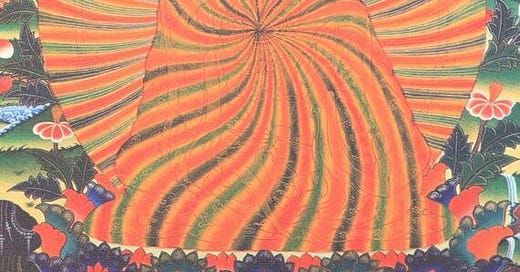Once again quantum physics and Buddhism intersect in their understanding of the nature of Reality when it comes to Light.
David Bohm was a rebel theorist of quantum physics who envisioned reality as an unbroken wholeness, where matter is the visible ripple of a deeper, implicate order. Bohm proposed that what we perceive as matter is, at its deepest level, a condensation of light, what he called “frozen light.”
To Bohm, light was not merely a physical phenomenon but a fundamental expression of the implicate order, the hidden, enfolded structure of reality from which the explicate, or visible world, emerges.
Matter, in this view, is light slowed down and folded into stable patterns, like standing waves of luminosity. Just as a hologram encodes the whole in every part, frozen light carries within it the potential for all forms, all motions, all consciousness. In this way, the universe is not built from inert substance but from dynamic intelligence suspended in radiant stillness.
This is a different way of saying the same thing that the Buddhist masters have been pointing out for thousands of years.
The completely open nature
of all dimensions and events
is a rainbow always occurring
yet never grasped.- Tilopa
Consider the Dzogchen view as pointed out by Keith Dowman, that great translator and teacher, wherein one experiences the luminous nature of reality through non-dual awareness:
“In non-duality the body is subsumed in the absolute impermanence of ever shifting light forms…the radiant sublime adornment of the vital energy of awareness where everything is rainbow light…
And just as the sun shines in the sky illuminating all that comes into its light so awareness shines with its own radiant luminosity. When this illumination is unobstructed, unimpeded and undifferentiated it takes the form of all-accomplishing wisdom and compassion. The radiance of this light reveals the secret of the body, of all materiality, as rainbow light.”
- J.M. White and Lamont Ingalls, Pulling a Torch From the Sky: The Radical Dzogchen of Keith Dowman
The difference between Bohm’s view, and the Dzogchen view is the difference between a conceptual understanding based on scientific theory and experimentation and the embodied experience of the luminosity of non-dual awareness.
Both views are necessary and useful in their own ways, but the Dzogchen view is the one that leads to liberation.
The question, then, is how Western science arrived at the same insights as ancient Buddhists, recognizing the illusory nature of matter and the primacy of light, yet did so in a way that does not lead to liberation.
The answer lies in neuroscience, in the different ways each hemisphere of the brain sees the world.





